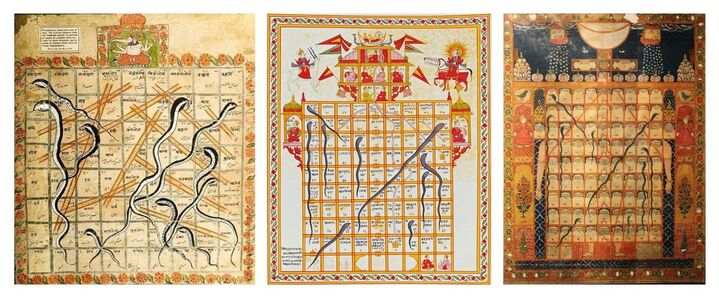Moksha Patamu is a part of a family of Indian dice board games in ancient India from the 2nd century. Moksha, in Hinduism means, release from the cycle of rebirth impelled by the law of karma. Patam is an object placed at the foot of a door to keep it from closing. Loosely translated it means obstacle on the way to gaining Nirvana.
It is associated with traditional Hindu philosophy contrasting karma and kama, or destiny and desire. It emphasized destiny and desire. The game has also been interpreted and used as a tool for teaching the effects of good deeds versus bad. The board was covered with symbolic images, the top featuring gods, angels, and majestic beings, while the rest of the board was covered with pictures of animals, flowers and people. The ladders represented virtues such as generosity, faith, and humility, while the snakes represented vices such as lust, anger, murder, and theft. The morality lesson of the game was that a person can attain salvation (Moksha) through doing good, whereas by doing evil one will be reborn as lower forms of life. The number of ladders was less than the number of snakes as a reminder that a path of good is much more difficult to tread than a path of sins. Presumably, reaching the last square (number 100) represented the attainment of Moksha (spiritual liberation).
A version of the game known as Gyan Chauper or Jnan Chauper (game of wisdom), is associated with the Jain philosophy, which encompassed the concepts of Karma and Moksha. There has even been evidence of a possible Buddhist version of the game existing in India during the Pala-Sena . Another version popular in the Muslim world is known as shatranj al-'urafa and exists in various versions in India, Iran, and Turkey. In this version, based on Sufi philosophy, the game represents the dervish's quest to leave behind the trappings of worldly life and achieve union with God. Although the game's sense of morality has lasted through the game's generations, the physical allusions to religious and philosophical thought in the game as presented in Indian models appear to have all but faded.
In Andhra Pradesh, this game is popularly called Vaikunthapali or Paramapada Sopana Patam (the ladder to salvation) in Telugu. In Hindi, this game is called Saanp aur Seedhi, Saanp Seedhi and Mokshapat. In Tamil Nadu the game is called Parama padam and is often played by devotees of Hindu god Vishnu during the Vaikuntha Ekadashi festival in order to stay awake during the night. In Bengali-speaking regions, West Bengal in India and Bangladesh, it is known as Shap Shiri or Shapludu respectively.
In the original game the squares of virtue are: Faith (12), Reliability (51), Generosity (57), Knowledge (76), and Asceticism (78). The squares of vice or evil are: Disobedience (41), Vanity (44), Vulgarity (49), Theft (52), Lying (58), Drunkenness (62), Debt (69), Murder (73), Rage (84), Greed (92), Pride (95), and Lust (99).
However, we tend to credit the Western world for the game and the common form available and played, known as the Snakes & Ladders. The association of Britain's Snakes & Ladders with India’s Moksha Patam began with the returning of colonial families from India during the British Raj. The underlying ideals of the game inspired a version introduced in Victorian England in 1862.The décor and art of the early English boards of the 20th century reflect this relationship. By the 1940s very few pictorial references to Indian culture remained, due to the economic demands of the war and the collapse of British rule in India. When the game was brought to England, the Indian virtues and vices were replaced by English ones in hopes of better reflecting Victorian doctrines of morality. Squares of Fulfilment, Grace and Success were accessible by ladders of Thrift, Penitence and Industry and snakes of Indulgence, Disobedience and Indolence caused one to end up in Illness, Disgrace and Poverty. While the Indian version of the game had snakes outnumbering ladders, the English counterpart was more forgiving as it contained equal numbers of each.
The basic concept of Snakes & Ladders was introduced in the United States in 1890 as Chutes and Ladders. Chutes and Ladders is produced by Hasbro and mainly distributed in the United States of America.

